Exploring the Unique Gemstones of Ireland
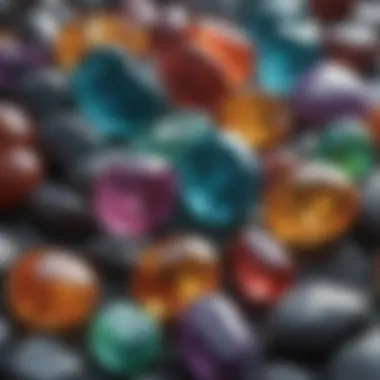
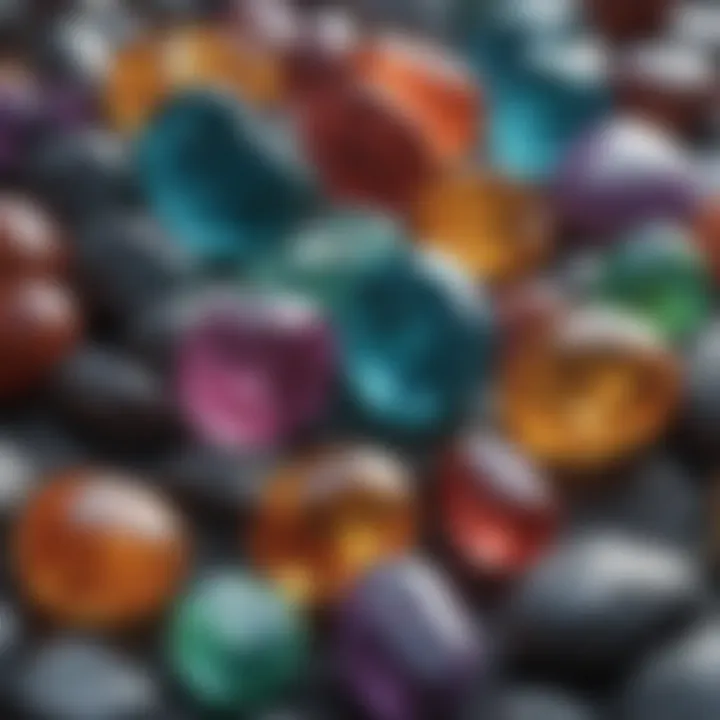
Intro
Ireland's landscape is not only a visual feast but is also home to a variety of gemstones that hold both natural beauty and significant cultural value. This article aims to explore the unique qualities of Irish gemstones, tracing their geological origins, cultural significance, and contemporary uses. The rich tapestry of stories woven around these stones connects the past with the present. Whether a seasoned collector or a curious newcomer, readers will find insights that enhance their understanding of this captivating topic.
Featured Collectible of the Month
Overview
In the realm of gemstone collecting, the Irish Connemara marble stands out as a compelling choice for enthusiasts. This marble, celebrated for its distinct green hues and patterns, has being revered for centuries. It is found primarily in County Galway, where it forms during specific geological processes, involving pressure and time. Collectors seek Connemara marble for its uniqueness and potential for intricate carvings or jewelry pieces.
Historical Significance
Connemara marble is steeped in history, linked with ancient Irish traditions and artistry. It is often considered a national treasure, employed in notable structures like the iconic St. Patrick’s Cathedral in Dublin. Its presence in historical artifacts adds to its allure.
"Gemstones link us to our past and inform our present; the Connemara marble exemplifies this relationship."
Identification Techniques
Visual Characteristics
Identifying gemstones involves careful examination of their visual features. For Connemara marble, look for the following characteristics:
- Color Variations: Ranges from deep emerald green to lighter shades.
- Patterns: Marble often displays unique swirls or veining, making each piece distinct.
- Texture: It may feel smooth to the touch, with a polished surface typical in crafted items.
Resources for Identification
For collectors seeking to validate their pieces, several resources exist:
- Books on Mineralogy: Reference texts provide essential characteristics and comparison images.
- Online Forums: Websites like Reddit and Facebook host groups dedicated to gem enthusiasts.
- Local Gem Shows: Attending these events can facilitate identification and networking with experienced collectors.
Prelims to Gemstones in Ireland
The realm of gemstones in Ireland presents a complex interplay of geology, culture, and artistry. This section offers essential insights into how such stones impact both the natural landscape and human experience. Understanding gemstones is not merely about identifying varying types; it is also about grasping their significance throughout history and their role in present-day society. An exploration of gemstones reveals a tapestry of lore, history, and craftsmanship that has evolved over centuries.
Overview of Gemstones
Gemstones, formed deep within the Earth, are minerals that undergo specific geological processes over millions of years. Ireland's geological landscape fosters unique types of gemstones. Not everyone understands the variety present in this small yet diverse island. Predominant gemstones such as Connemara marble, agates, and even jade are often overlooked. Each type has a distinct story, tied to the land and shaped by natural forces.
The identification of these gemstones involves geological knowledge, as well as an appreciation for the cultural context in which they exist. Rock and fossil collectors often find this aspect particularly compelling. Their journeys into the field not only provide opportunities to collect but also to deepen their understanding of geology.
Significance of Gemstones in Irish Culture
Gemstones in Ireland carry significance that extends far beyond aesthetics. They are woven into the fabric of Irish mythology, folklore, and craft. Historically, certain stones were believed to hold protective qualities or bring good fortune. For instance, jasper has been associated with grounding forces, while agate's diverse range of colors is often linked to personal attributes.
In contemporary Ireland, gemstones feature prominently in jewelry design. Artisans employ traditional and modern techniques to create pieces that reflect cultural identity and heritage. Collectors value not only the physical beauty of these stones but also the stories behind them. This cultural significance elevates the experience of collecting gemstones into a journey of connection with Ireland's past, present, and future.
"The beauty of gemstones lies not only in their sparkle but also in their heritage, representing stories that transcend time."
By recognizing the significance these stones hold within Irish culture, one can appreciate the intertwined relationship between nature, history, and human expression. Collecting gemstones thus becomes an exploration of both physical and metaphysical realms, merging geology with culture.
Geological Foundations of Gemstones
Understanding the geological foundations of gemstones is crucial for appreciating the beauty and rarity of these treasures found in Ireland. The formation of gemstones is deeply rooted in the country’s unique geological context. It entails not just the scientific processes behind gemstone creation but also the implications of these processes for rock collectors and enthusiasts.
The Geological Context of Ireland
Ireland's geology consists of a complex mixture of ancient rock formations, sedimentary layers, and volcanic activity. The country is primarily constructed from limestone, sandstone, and granite, all of which contribute to the mineral diversity available in the region. The rich geological history, shaped by both tectonic movement and erosion, creates ideal conditions for gemstone formation.
In particular, the folds and faults within the Earth's crust play a significant role in how minerals crystallize, leading to different types of gemstones, including quartz, agate, and jade. Additionally, the varying conditions of temperature and pressure in different parts of Ireland contribute to the distinct types of stones that can be discovered. Different geological periods have left their marks, adding layers of complexity.
Formation Processes of Gemstones

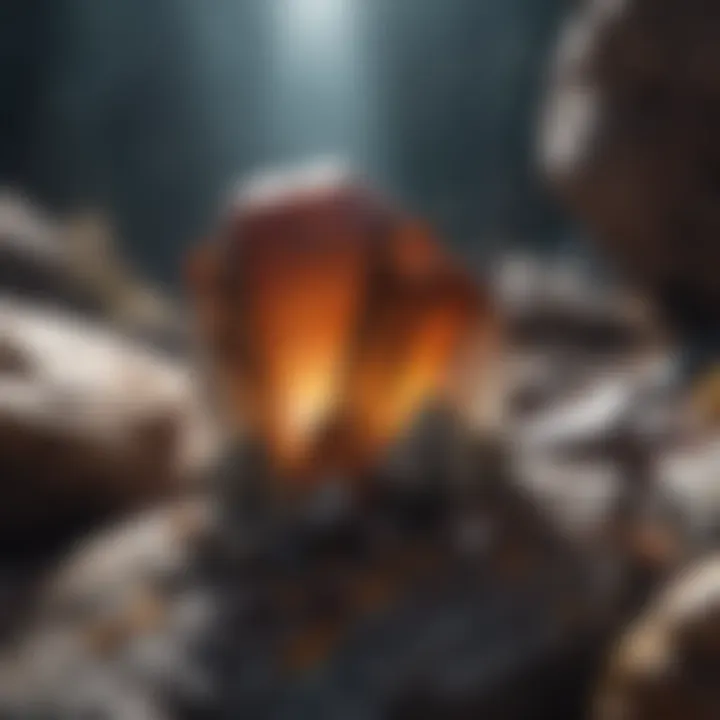
Gemstones primarily form through four main processes: crystallization from magma, precipitation from mineral-laden water, metamorphism under heat and pressure, and organic processes in specific environments.
- Crystallization from Magma: This happens when molten rock cools and solidifies. For instance, as magma rises, it may give rise to minerals like quartz and topaz. Different cooling rates lead to different crystal sizes and structures.
- Precipitation: Gems can also form when water evaporates in mineral-rich environments, leaving crystals behind. This can be seen in formations like certain types of calcite found in limestone regions.
- Metamorphism: Over millions of years, existing minerals can undergo changes due to intense heat and pressure, transforming into new gems. An example is how shale can metamorphose into garnet under the right conditions.
- Organic Processes: Some gems, like pearls and amber, are formed through biological processes. Pearls create in oysters, while amber occurs from the fossilization of tree resin.
A correct understanding of these formation processes allows collectors to appreciate the intrinsic value of gemstones, knowing they are not merely beautiful, but also products of time, earth, and nature's spectacular forces.
Through examining these geological foundations, one can grasp not only the allure of Irish gemstones but also their stories and significance in the broader context of natural history.
Types of Gemstones Found in Ireland
Understanding the types of gemstones found in Ireland is essential for anyone interested in the country’s geological wealth. Ireland offers a variety of gemstones, each with its unique characteristics and significance. These stones not only provide aesthetic value but also carry historical and cultural importance. They play a vital role in the local economy and artisan crafts. The following sections investigate three notable types of gemstones found in Ireland, focusing on their local varieties, charm, and the unique qualities they bring to the gemstone landscape of the country.
Local Variants of Agate
Agate is one of the most common gemstones found in Ireland, particularly known for its colorful banding patterns. Local variants boast many colors, including reds, greens, and blues, with banding that can be quite intricate. These stones are often sourced from riverbeds or coastal areas, where natural forces have shaped them over time.
Agate is often associated with grounding and stabilizing properties, making it popular among collectors and those interested in holistic practices. Many enthusiasts appreciate its beauty and the uniqueness of each specimen.
When collecting local agate, it is crucial to identify authentic pieces. Inspecting the stone for its banding and texture will help differentiate between genuine agate and other similar-looking stones. Proper care during the collection process can also ensure that the beauty of these stones is preserved.
The Charm of Connemara Marble
Connemara marble is another gem that holds an esteemed place in Irish heritage. This stone is known for its rich greens and distinctive veining. The marble is unique to Ireland, offering a distinct charm that cannot be found elsewhere. Much of this stone originates from the Connemara region, which is why it carries the name.
Because of its bold patterns and durability, Connemara marble has become a popular choice among artisans for crafting jewelry and decorative pieces. The historical aspect adds to its allure, as Irish artisans have used this stone for centuries in sculptures and architecture.
Collectors often seek Connemara marble for its rarity and significance, finding joy in both its aesthetic and its Irish narrative. Understanding the source of this marble can enhance its value and meaning to collectors.
Exploring Irish Jade
While jade is often associated with other regions, Ireland also presents its versions of this precious stone. Irish jade is typically found in shades of green and sometimes has intricate patterns and textures. Its presence adds to the diversity of gemstones found in the country.
In contrast to other well-known forms of jade that are harder and denser, Irish jade can differ in its quality and appearance. The local jade is less commonly harvested, making it a collector's delight. This rarity reflects its unique cultural significance and desirability.
Collecting Irish jade requires keen observation skills to distinguish it from similar stones. Factors such as color, texture, and veining play a crucial role in identifying these pieces. Given its lesser-known status, obtaining Irish jade can be particularly rewarding for collectors who appreciate unique finds.
Collecting Irish gemstones offers both a historical narrative and an engaging hobby, reflecting the diverse beauty present in Ireland's landscape.
Historical Perspectives on Gemstones
The exploration of gemstones in Ireland is deeply intertwined with the country’s history. Understanding historical perspectives on gemstones reveals not only their physical properties but also their roles in cultural identity, trade, and artistry. This section aims to underline the significance of gemstones in the historical narrative of Ireland, as well as their evolution through time.
Gemstones have been utilized for various purposes in Ireland, from adornment to ritualistic uses. Their rarity and beauty often made them symbols of wealth and power. The historical context serves as a vital foundation for comprehending current perceptions and values surrounding these beautiful stones. Analying ancient practices brings insight into how people interacted with the natural world, particularly through the gemstones they collected and modified.
Historical Uses of Gemstones in Ireland
Gemstones in Ireland have been used for numerous purposes throughout history. They have adorned the royals as symbols of wealth and status, and served practical functions in health and spirituality. Examples include:
- Jewelry: Used in necklaces, rings, and crowns, gemstones such as gold, pearl, and amber were highly valued.
- Amulets and Talismans: Various stones were believed to hold supernatural powers. They were worn or carried for protection and good fortune.
- Trade Goods: Gemstones were often traded with neighboring cultures, establishing them as significant items in early commerce.
"The significance of gemstones transcends mere decoration; they embody history, culture, and identity."
Over time, the way gemstones were used in craftsmanship has transformed dramatically. In the early periods, they were often shaped and polished without intricate designs. As artisan skills advanced, more sophisticated techniques emerged, leading to unique Irish styles.
Notable Discoveries and Finds
Several notable discoveries highlight the importance of gemstones in Irish history.
- The Tara Brooch: This exquisite piece of jewelry from the 8th century features gemstones set in a complex arrangement, showcasing early Irish craftsmanship.
- The Ardagh Chalice: Dating back to the 8th century, this chalice includes gemstones and reflects religious and ceremonial significance.
- The Tullydonnell Hoard: A collection unearthed in County Donegal, this hoard of early medieval silver and gold jewelry, along with gemstones, demonstrates the wealth of ancient Irish chieftains.
These items provide a glimpse into the artistic capabilities and societal values of their time. They also present opportunities for collectors today to appreciate not only the gemstones but the stories embedded in their historical context.
Gemstones in Irish Folklore and Mythology
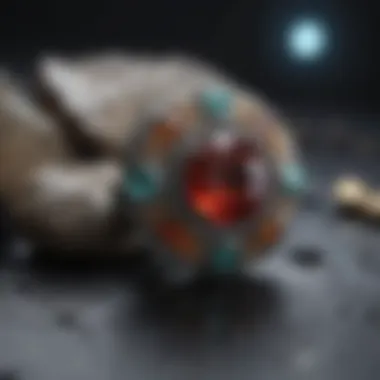
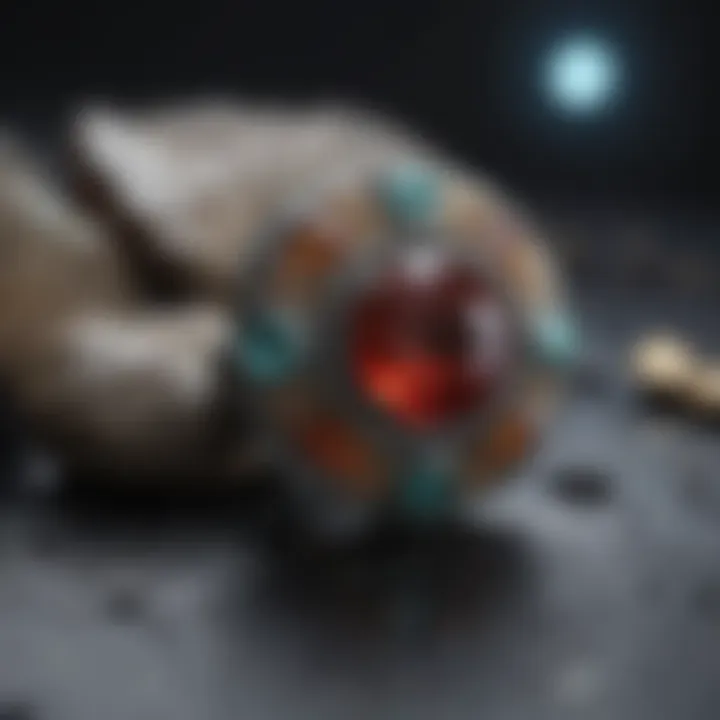
Gemstones hold a notable place in Irish folklore and mythology, weaving a rich tapestry of cultural narratives that enhance their intrinsic value. This section serves to underscore the connections between these precious stones and the stories, traditions, and beliefs they represent. The role of gemstones is not merely decorative; they encapsulate historical significance and social purpose that permeated Irish society. By examining cultural myths surrounding gemstones, we can appreciate their deeper meanings and the unique influence they wield in the lives of the Irish people.
Cultural Myths Surrounding Gemstones
In Irish culture, gemstones have long been linked to various myths that capture the imagination. One prominent belief is that certain stones possess magical properties. For example, opal is often seen as a stone of inspiration and creativity, believed to bring prosperity to its owner. There are also tales that suggest amber, with its warm hue, can act as a protector from negative energies. Many Irish legends feature characters who wield supernatural powers, often channeling or employing the energies of gemstones to achieve their goals.
Additionally, gemstones are believed to be associated with natural elements, embodying earth's powers. Some families might even pass down heirloom pieces made of specific stones, believing they carry ancestral strength and wisdom. These practices exemplify the integration of gemstones into daily life and spiritual beliefs, making them more than mere objects but instead, vital parts of Irish identity and heritage.
Folkloric Significance of Specific Stones
Certain stones have acquired specific folkloric significance in Ireland. The following are a few notable examples:
- Connemara Marble: This stone, unique to Ireland, is often referenced in stories as a symbol of resilience and history. Its green hues are echoed in tales of the land's lush landscapes and deep roots in Irish culture.
- Garnet: Known for its beauty and durability, garnet is often featured in tales of warriors and noble figures. It symbolizes loyalty and friendship, believed to protect its wearer during travel.
- Amethyst: Associated with protection and clarity of mind, amethyst stones have a rich history in Irish culture. They are said to enhance wisdom and promote spiritual growth, reflecting the qualities valued in Irish mythology.
Overall, these stones take on identities and significance beyond their physical attributes. They are rooted in stories, ethics, and the collective consciousness of generations, rendering them integral to understanding Irish folklore and mythology.
Gemstones in Ireland carry stories that transcend mere aesthetics; they represent cultural roots and the complex interplay between the natural world and human belief systems.
Practical Aspects of Collecting Gemstones
Collecting gemstones is a pursuit that requires knowledge and discernment. It not only satisfies a personal interest but also serves to appreciate the geological and cultural heritage of Ireland. The importance of this topic lies in the multifaceted benefits it offers to both novice and seasoned collectors. Understanding how to identify authentic gemstones and recognizing best practices in collecting can significantly enhance one’s experience and success in this field.
Identifying Authentic Gemstones
To ensure the value of your collection, recognizing authentic gemstones is crucial. The gemstone market can be rife with imitations and lower-quality stones. Here are some key factors to consider:
- Visual Inspection: Look for clarity and color saturation. Genuine gemstones typically exhibit unique characteristics. For example, high-quality Connemara Marble has distinctive green hues with variations.
- Hardness Test: Utilize the Mohs scale of mineral hardness. For instance, if you scratch a piece of quartz with a fingernail, you should see that quartz remains undamaged, confirming its authenticity.
- Refraction: Gemstones can have different refraction ratings. Tools like a refractometer help determine if a gemstone’s characteristics match known values for that type.
“Understanding the properties of gemstones helps distinguish genuine stones from imitations.”
- Certification: Whenever possible, seek gems that come with proper certification from gemological laboratories. Certificates can validate the stone's quality and origin, which increases your confidence in your purchase.
Best Practices for Collecting
Gathering gemstones necessitates a disciplined approach. Adopting best practices will help in building a reputable collection. Consider these steps:
- Research Prior to Acquisition: Knowledge is power. Before purchasing a gemstone, research its origin, rarity, and typical pricing. Knowledge of local finds can be particularly useful for Irish gemstones, such as local agate variants.
- Ethical Sourcing: Focus on acquiring gemstones from reputable dealers or local mines that follow ethical practices. This not only supports local economies but also aligns your collecting with sustainable methods.
- Care and Storage: Proper care can prolong the beauty and integrity of gemstones. Store them in soft pouches or padded containers to avoid scratches. Keep them away from direct sunlight to prevent fading.
- Documentation: Keep track of your purchases. Document where and when you acquired the stones, along with any certification or appraisal paperwork. This practice not only aids future sales but also enriches the history of your collection.
In summary, understanding the nuances of identifying authentic gemstones and adhering to best practices for collecting enhances both the personal satisfaction and value of your collection. The meticulous steps you take can lead to a rewarding venture into the world of Irish gemstones.
The Market for Irish Gemstones
The market for Irish gemstones holds significance not only for collectors but also for the broader economy and cultural identity of Ireland. The demand for unique gemstones, especially those with local origins, is increasing. Collectors and enthusiasts are looking for pieces that tell a story, making Irish stones particularly appealing.
Overview of the Gemstone Industry
The gemstone industry in Ireland has been shaped by both historical and modern influences. Mining operations, small-scale artisan businesses, and independent jewelers contribute to this multifaceted market. Key gemstones such as Connemara marble, Irish jade, and various agates find their value not just in their aesthetics but also in the craftsmanship that goes into creating jewelry and decorative pieces.
Irish gemstones are often marketed as unique pieces of art, appealing to both local and international audiences. Various fairs and markets showcase these stones, allowing collectors the opportunity to purchase direct from artisans. This also helps keep traditional techniques alive, as modern jewelry makers incorporate old skills into new designs.
Factors Influencing Market Trends
- Authenticity: The story behind the stones enhances their value.
- Sustainability: An increasing number of buyers are concerned with the environmental impact of gemstone sourcing.
- Cultural Identity: Gemstones that connect with Irish folklore or heritage are sought out, reflecting a collective national pride.
Challenges Facing the Industry
The gemstone marketplace in Ireland faces a series of challenges that may impact its growth and sustainability.
One significant challenge is the competition from imported stones. Global markets often favor more common gemstone sources, making it difficult for local artisans to compete on price. This can dilute the market for Irish gemstones.
Another issue is environmental concerns. As awareness of sustainability increases, there is a rising demand for stones that are ethically sourced. High expectations from consumers can put pressure on the industry to adapt.
Additionally, economic factors play a crucial role in the gemstone market. Economic downturns can lead to decreased spending on luxury goods, including gemstones. When consumers prioritize essential expenditures, the market for collectibles and artisanal pieces can stagnate.
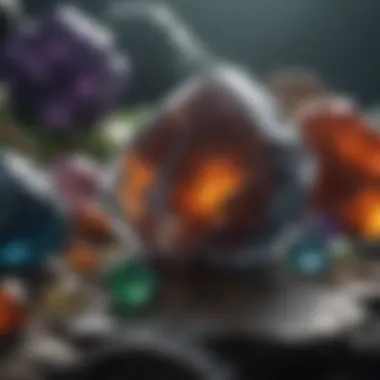
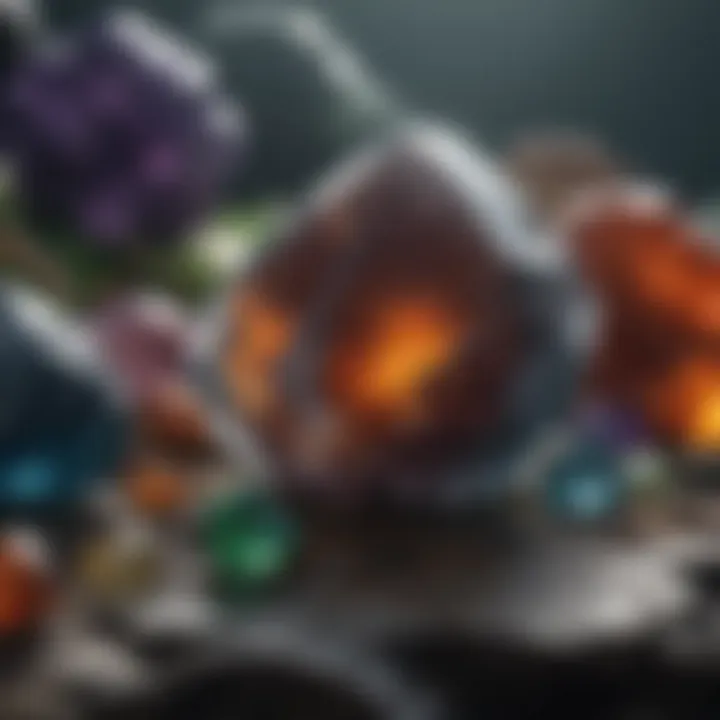
In summary, while the market for Irish gemstones has promising potential due to its rich cultural history and unique offerings, it is imperative for stakeholders to navigate these challenges skillfully to ensure the industry's longevity.
"The future of the gemstone industry hinges on balancing tradition with modern expectations, embracing sustainability while staying true to unique Irish heritage."
Explorations into new marketing strategies and educational efforts about the value of Irish gemstones will assist in intercepting these challenges. Collectors can play an essential role in this story by supporting local artisans and advocating for authentic, ethically sourced materials.
Gemstone Craftsmanship and Jewelry
Gemstone craftsmanship and jewelry design in Ireland constitute a vital aspect of the country's cultural and artistic heritage. This section delves into the intricate skills and techniques involved in gemstone setting, as well as the contemporary trends that shape Irish jewelry design today. Understanding these elements is crucial not only for appreciating the beauty of the gemstones but also for recognizing the talent and creativity behind their transformation into wearable art.
Techniques in Gemstone Setting
Setting gemstones is a meticulous process. Artisans often utilize various techniques to ensure both aesthetic appeal and stone security. Key methods include:
- Prong Setting: This popular technique uses metal prongs to secure the stone while allowing light to pass through, enhancing brilliance.
- Bezel Setting: The stone is encircled by a metal rim, providing a sturdy hold and a sleek, modern look.
- Pave Setting: Many small stones are set closely together, creating a uniform glittering surface.
- Channel Setting: Stones are set in a continuous row within a metal channel, which is ideal for showcasing multiple stones in a single piece.
Each method requires precision and a keen eye for detail. Jewelers often need to adjust the settings repeatedly, ensuring that the final piece meets quality standards and exhibits a flawless finish. This craftsmanship not only protects the gemstones but also elevates them into pieces worthy of admiration.
Contemporary Irish Jewelry Design
Irish jewelry design today reflects a blend of traditional practices and modern innovation. Designers are increasingly embracing sustainable techniques and local materials, honoring the rich geological heritage of Ireland. Some trends observed in contemporary Irish jewelry include:
- Nature-Inspired Designs: Jewelers draw inspiration from Ireland's landscapes, flora, and fauna, creating pieces that resonate with the country’s beauty.
- Emphasis on Craftsmanship: There is a renewed focus on artisanal pieces, where handmade qualities stand out amid mass-produced alternatives.
- Personalization: Many designers now offer customization options, allowing clients to create unique pieces that reflect their personal stories.
- Use of Native Stones: Incorporating local gemstones, like Connemara marble and Irish jade, enhances the authenticity of the jewelry.
Contemporary Irish jewelry not only appeals to a wide audience but also encapsulates the spirit of Ireland through its stones and craftsmanship. A piece of jewelry is often more than an accessory; it serves as a narrative — celebrating the country’s geological abundance and artistic creativity.
It is essential to recognize how gemstone craftsmanship links the past to the present, merging tradition with modern artistry.
Environmental Considerations
The exploration and use of gemstones can have significant environmental impacts. This section examines how gemstone mining practices affect the Earth, emphasizing the need for sustainable methods. Understanding these elements is crucial for collectors and enthusiasts who want to engage with this field responsibly.
Sustainable Practices in Gemstone Mining
In recent years, there has been a growing awareness of sustainable practices in gemstone mining. \nThese practices aim to minimize environmental degradation while still allowing for the extraction of valuable stones. Key strategies include:
- Selective mining techniques: These methods focus on extracting stones without causing unnecessary damage to surrounding areas.
- Rehabilitation of mining sites: After mining, areas should be restored to bring back local flora and fauna. This approach helps maintain biodiversity.
- Use of eco-friendly equipment: Employing technology that reduces emissions and energy consumption can greatly lower the environmental footprint of mining operations.
Furthermore, collaborative initiatives among gem traders, local communities, and environmental organizations have been launched. These collaborations often focus on educating miners about the benefits of sustainable practices, ensuring a balanced coexistence of gemstone extraction and environmental conservation.
Impact on Local Ecosystems
Mining activities can disrupt local ecosystems significantly. When land is cleared for mining, it not only removes vegetation but also affects wildlife habitats. Some key impacts include:
- Habitat Destruction: Clearing land for mining removes homes for various species, putting pressure on already fragile ecosystems.
- Soil Erosion: The removal of trees and plants exposes soil, making it vulnerable to erosion, which can lead to long-term degradation of the land.
- Water Pollution: Runoff from mining operations can introduce harmful substances into local water bodies, affecting both aquatic life and communities that depend on these water sources.
"The health of an ecosystem is vital for the sustainability of the local environment and communities. Gemstone enthusiasts must consider these aspects when supporting the industry."
Maintaining environmental integrity involves thorough assessments before any mining activity begins, taking into account the potential detrimental effects on nature. Ultimately, future gemstone projects must align with ecological preservation to sustain both the industry and the terrestrial health.
Understanding these environmental considerations ensures that collectors and enthusiasts approach the gemstone market with awareness, supporting practices that not only celebrate the beauty of gems but also uphold a commitment to the planet.
Closure and Future Perspectives
The exploration of gemstones in Ireland reveals more than just the geological and cultural significance of these captivating treasures. Through this article, we have uncovered various aspects ranging from their formation processes to their roles in folklore and commerce. Understanding the importance of gemstones not only enhances our appreciation for these beautiful stones but also highlights their place in Irish history and identity.
In summary, gemstones found in Ireland are more than mere decorative items. They embody centuries of history, pride, and innovation. The local variants of agate, the unique Connemara marble, and the seldom seen Irish jade all reflect the diverse natural wealth of the country. Additionally, the skills of contemporary Irish artisans in gemstone craftsmanship and jewelry design showcase a blend of tradition and modernity. The rich cultural tapestry surrounding these stones contributes to their significance, influencing both local artisans and gem collectors alike.
Summary of Findings
Throughout this exploration, key points emerged that enhance our understanding of Irish gemstones:
- Geological Context: Ireland’s geological foundations provide a perfect backdrop for diverse gemstones, shaped over millions of years.
- Cultural Relevance: Gemstones serve as symbols within Irish folklore, each telling a unique story tied to the landscape.
- Sustainability: The rise of eco-friendly practices in gemstone mining reflects a growing awareness of environmental impact.
- Market Dynamics: Challenges in the gemstone industry present both risks and opportunities for local vendors and collectors.
The Future of Gemstones in Ireland
The future of gemstones in Ireland appears promising yet complex. As awareness grows around sustainable mining, many local businesses are adapting to eco-friendly practices. This is essential for ensuring that the enjoyment of collecting and utilizing gemstones does not come at the cost of environmental degradation.
New collectors and seasoned enthusiasts alike must pay attention to market trends. The increasing demand for authenticity in gemstones presents a chance for genuine Irish stones to shine in the global market. Innovators in both the mining and jewelry sectors are exploring ways to combine historical techniques with modern technology, creating unique pieces that carry significant meaning.



